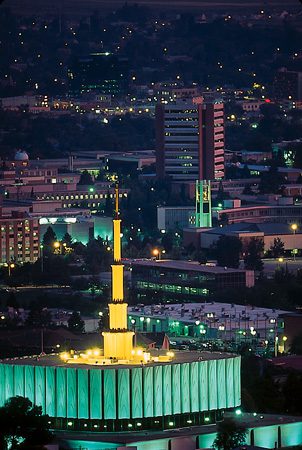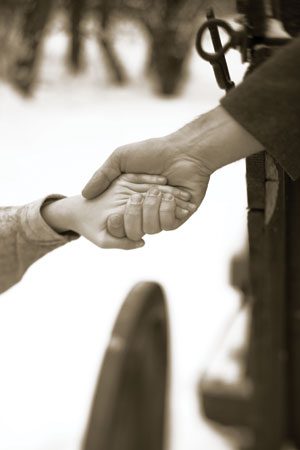By President Merrill J. Bateman
An educated worldwide membership is important to the long-term development of The Church of Jesus Christ of Latter-day Saints. Wherever President Gordon B. Hinckley goes, he encourages the youth of the Church to obtain an education. He understands not only that education is important for their temporal and spiritual welfare but also that educated people are important assets in building the kingdom.
In coming years rapid Church growth will produce hundreds of thousands, if not millions, of first-generation LDS young adults. Some will have prepared themselves to pursue an education at an institution of higher learning. Others will not be so fortunate. Many of these young men and women could benefit immensely if taught some basic skills and encouraged to obtain further education. For the most part their problem will not be intellectual capacity. Rather, they will be constrained by economic and sociological barriers. If historical patterns prevail, it will take members two or three generations in the Church before they overcome the personal and social barriers and acquire the financial resources to attend a university.
As the Church moves beyond the first generation in foreign lands, LDS student demand for higher education will increase. The educational status of Church members across the world will improve over time because of the impact of Church teachings on each individual. Revealed truths regarding the importance of education, combined with prophets emphasizing the same, raise expectations among faithful members and encourage them to increase their efforts to improve themselves. In other words, revealed truth increases the demand for education. Brigham Young University has been, is, and will continue to be at the center of this educational revolution.
Church growth, then, is one of the most important factors that will define the future of BYU. The impact of this growth on BYU will manifest itself in a couple of ways. First, the pool of potential faculty, staff, and students will increase by three times or more in the next 25 years. There will be an even more select group of potential students from which to draw. The same will be true of the faculty. A greater and greater percentage of BYU graduates will attend graduate school. More and more LDS undergraduates at other universities will pursue graduate degrees. The pool of potential faculty will increase three or four times. The pool of experienced LDS faculty teaching at other universities will grow. I believe that the impact of these changes resulting from Church growth is that the quality of education at BYU will improve faster than at other institutions of higher learning. I also suspect that these changes will bring additional pressure on the university to increase its graduate programs. The university’s emphasis on undergraduate education will be tested in the future, as it has been in the past.
Second, not only will the quality of students, faculty, and staff improve in the years ahead but the university will become more diverse. The number of foreign students will rise. Currently between 7 and 8 percent of the student body comes from foreign countries. One suspects that the percentage will increase to between 15 and 20 percent, given Church growth outside North America. Because there are some advantages to being educated in one’s native land and because economic barriers will continue to exist, the growth rate in foreign student demand may not keep pace with the growth of the Church in foreign countries. Still, the increasing quality of BYU will be a magnet for students no matter where they live.
One suspects that racial and cultural diversity at the university will increase faster than overall Church growth. Convert growth rates are higher outside North America, and my impression is that conversion rates for Hispanic and black Americans are higher in North America than the rate for Caucasians. There will be strong, natural forces increasing the racial, ethnic, and cultural mix on campus.
Technology and Education
Education will continue to be streamlined with the aid of technology. Lectures, data, class assignments, reading materials, exams, and other tutorial materials will be online and on CD-ROM. Students will access online information from their homes before they arrive at BYU, from their dorms after arrival, from the library, from other buildings on campus, and eventually by antennae from any location. When used appropriately, new technology has the capacity to reduce lecture time and allow for more discussion groups, seminars, and labs. To the extent that technology increases learning effectiveness, it may increase opportunities for students to be involved in research projects and free up time for faculty research. We believe that students will be able to spend a semester off campus with some courses taken at a distance. Pilot projects exploring these possibilities are under way.
BYU’s Division of Continuing Education currently services more than 40,000 students. Most of the courses at present are on paper and through the mail. During the past year approximately 20 university courses have been converted to the Internet. Plans call for 50 courses on the Internet by the end of 1998, with 300 or more courses available electronically within the next five years. The new Internet courses are enriched well beyond their paper predecessors. A student anywhere in the world may enroll in a course by accessing BYU’s main Web site. Payment for the course may be done over the Internet. A CD-ROM sent to the student contains the video materials, and the disk works seamlessly with the Internet to provide video of the professor and enriched materials.
The first BYU course on the Internet was Religion 324, the first half of the Doctrine and Covenants. The first person to sign on was a member in Japan. The first person to complete the course was a young, nonmember woman at a university in California. She was studying comparative religions and received permission to take the BYU course as part of the series.
As the number of Internet courses multiplies, so will the number of students served across the world–and at a much reduced cost. We expect the number of students enrolled in distance-learning courses to multiply many times as students learn about the courses on the Web. The quality of interactive multimedia material available online will improve considerably with time and will become even more effective in both transmitting knowledge and providing a learning experience.
I foresee the day when BYU Web programs will prepare LDS students in foreign lands to enter universities and/or find employment. Retired professors and their wives will be called on missions to serve as tutors in foreign countries to help young adults complete BYU Web courses and prepare for entrance exams. If our reputation is strong enough, LDS students living outside the United States will complete a university degree by taking a combination of BYU courses over the Internet and courses at the local university. Currently, pilot projects in Monterrey, Mexico, and São Paulo, Brazil, are laying the foundation for these possibilities.
The Lord’s Plan for BYU
Is the Lord interested in Brigham Young University? Is it an integral part of the Church? Does he have a plan for BYU? A story involving President John Taylor is instructive with regard to the Savior’s interest in and commitment to the university. Some months after becoming president of the Church, President Taylor was visited by
Zina Young Williams, the dean of women of the Brigham Young Academy in Provo and a daughter of Brigham Young. The academy was less than a decade old and was experiencing serious financial difficulties that, if not resolved, would mean its closing. After listening to Sister Williams’s plea for help, President Taylor took her hand “in a fatherly way” and said: “My dear child, I have something of importance to tell you that I know will make you happy. I have been visited by your father. He came to me in the silence of the night clothed in brightness and with a face beaming with love and confidence told me things of great importance and among others that the school being taught by Brother [Karl G.] Maeser was accepted in the heavens and was a part of the great plan of life and salvation; . . . and there was a bright future in store for . . . preparing . . . the children of the covenant for future usefulness in the Kingdom of God, and that Christ himself was directing, and had a care over this school.” [Leonard J. Arrington, ed., The Presidents of the Church (Salt Lake City: Deseret Book Co., 1986), pp. 108-109]
It is clear from President Taylor’s statement that the university is an integral and important part of the Lord’s kingdom. The Lord has a plan for BYU. It has played and will continue to play a central role in educating members of the Church. There are times when it would be helpful to have the Lord’s blueprint for the university for all to see–but that is not how he operates. Generally the Savior provides a broad outline and a set of principles. He then asks his servants to seek and listen to the Spirit in order to fill in the details.
BYU must be a world-class university. This distinctiveness will come if we follow the counsel of Elder Dallin H. Oaks in a recent fireside. We must be willing to go the extra mile in our teaching and research because we have the “covenant of fire” within. If we are covenant disciples, we will not neglect the gifts we have to offer, and our sacrifice will build a Zion university that excels.









